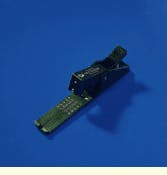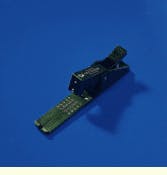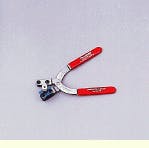Karen Graziano
Is it possible to make a good thing even better? Cleaver and scribe manufacturers say, "Yes." During the past 20 years, manufacturers have refined and improved cleavers. Recent improvements include creating wider wedges for easier use and control, and developing multiple fiber cutting tools for greater speed and precision. Installers` priorities, easy handling, reliability, consistency, and price in a given application always factor into purchasing decisions, but when it comes to cleavers and scribes, the determining factor is really personal preference (see Product Update table, page 72).
Cleaving, considered an art form, matches the skill of the installer with the precision of a cleaving tool. Installers correlate a cable`s performance with the quality of the cleave. The better the cleave or cut, the better the cable`s performance. This explains why installers regard a cleaving tool as an essential part of an installer`s tool kit. "If you don`t cleave a fiber correctly, you won`t get a good polish, and you`ll lose decibel," says Mike Mitchell, project manager of Communications Diversified Inc. (Albuquerque, NM). "A poor cleave will leave a crack down the fiber that you can`t remove by polishing, and these cracks tend to migrate down below the ferrule endface of the fiber-optic connector," agrees Rick Nielsen, application engineer at csi/Automatic Tool & Connector Corp. Inc.
When purchasing a cleaver or scribe, installers first appraise a tool`s appropriateness for the intended applications. Handheld pen-shaped scribes and handheld cleavers score fibers before polishing; handheld manual and simple mechanical cleavers prepare fibers for fusion splicing; and sophisticated mechanical cleavers prepare fibers for more-demanding splicing applications.
Pen-shaped scribes
Considered the traditional and most popular cleaving tool, pen-shaped scribes are also the least expensive cleaving option, priced from $20 to $40 each. Although scribes cut fewer fibers at a time than mechanical cleavers, their small size and portability attract installers. Mitchell, an experienced cabling installer, prefers handheld scribes rather than mechanical cleavers. "At my jobs, I only need to cleave six or twelve fibers at a time, so I always choose a manual cleaver. To manually cleave the fiber takes about 30 seconds and to polish takes about 1 minute," says Mitchell.
Many installers, especially inexperienced ones, admit that scribes do not provide the cleave uniformity, precision, and accuracy of mechanical cleavers. "It is more difficult to get repeatable consistent scribes and achieve cleave angles with a handheld scribe unless you have the expertise of a full-time fiber-optic cable splicer," explains Eric Anderson, product manager at Fitel Lucent Technologies. Tony Dorin, product manager at Molex Fiber Optics Inc., disagrees: "It takes less training to use a handheld tool properly. The handheld tool minimizes damage likely to occur to the fiber where it passes in the ferrule and consequently reduces the number of connectors that installers must throw away."
Mechanical cleavers, available in simple handheld and more-sophisticated desktop versions, afford installers more advantages than do scribes. Cleavers, like scribes, are portable, but cut fibers more precisely and accurately. They are also more expensive, costing $100 to $1000.
Simple mechanical cleavers, such as the stapler-type cleaver, are generally for field use. Fitel Lucent Technologies` small, rugged, stapler-type cleaver is well-suited for field use, such as in emergency-repair situations. You score the fiber by pressing down on the tool`s lever and cleave the fiber by bending down its flexible platform. "It is portable so you can run out in the field with this tool and do repair work," explains Anderson. "The stapler-style cleaver is a cost-effective choice that yields good cleaves. The cleave angle won`t be as consistent as [that of] a more complex mechanical cleaver, but its simple, reliable design is compatible with all popular mechanical splices."
Emergency fiber restoration kits commonly include fiber cleavers, such as Clauss`s simple mechanical cleaver, used by telephone companies to temporarily repair breaks in cable. Clauss`s cleaver locks each fiber end in place and cuts the fiber endface, eliminating jagged edges and leaving a clean endface. After completing this cleaving operation, installers typically employ a sophisticated fusion splicer to weld or fuse two pieces of fiber together, explains Tom Reinert, Clauss`s national sales manager. When cleaving 100 or more fibers at a time--common for large installations--installers opt for a sophisticated cleaver and fusion splicer, according to Communications Diversified`s Mitchell. Clauss`s Reinert states, "It isn`t unusual for at&t or Lucent to spend $15,000 to $30,000 on a fusion splicer."
More factors to consider
Focusing on two essential qualities of cleavers--consistency and repeatability--manufacturers developed cleavers with stoppers, mounting tools, and larger wedges. Molex Fiber Optics designed the pen-shaped Universal Cleave Tool with a self-contained, trigger-activated mechanism that cleaves to a predetermined length for the endface for optimum consistency and repeatability. "The Universal Cleave Tool`s stopper determines a uniform length in every termination so you can predict the number of polishing moves required to get the fiber in line with the endface," Molex`s Dorin explains. "It does take a great deal of the human factor out of it."
To ensure consistency, Valdor Fiber Optics designed the Auto-Cleaver. The device attaches to the Impact Mount Termination Tool, a 3 x 91/2-inch table-mount tool that features a simple slide-and-release operating mechanism that produces consistent cleaves. By securing the fiber tip, the mounting device prevents movement and ensures a clean cut. Impact Mount Technology presents a quick and effective approach for fiber termination, according to Valdor Fiber Optics.
Manufacturers experimented with new ways to improve handheld scribes and cleavers by varying wedge sizes. Larger wedges provide greater control, better handling, and eventually more speed, manufacturers claim. As a result, installers can cleave fibers faster and get better results. Automatic Tool & Connector makes an industrial sapphire that has a wide wedge shape. "It increases control," says Automatic Tool`s Nielsen. "Larger wedges are easier for a beginner to control and give a better score than the diamond-tipped ball-point pen scribes. It takes a lot more practice to use a smaller-tipped tool, so the trend is toward a larger scribing device. It is more difficult to control the ball-point pen without breaking off the fiber prematurely. It takes better penmanship and practice to do it correctly."
Many educators and trainers favor a narrow tip, such as Clauss`s retractable diamond pen-shaped wedge. "An industry trainer probably would not support the use of a wider-wedged cleaver because it would invite a student to saw on the fiber rather than simply nick it," says Reinert. "I don`t see any reason for a larger wedge. The one that we have is only a quarter of an inch wide. I don`t need anything much wider than the ferrule itself," says Mitchell.
Cutting multiple fibers
Creating cleavers that cut a dozen fibers together is becoming a new trend. Three Japanese companies are now manufacturing tools that cut multiple fibers. Simultaneous cleaving increases speed, efficiency, and precision. Sumitomo`s Precision Ribbon Fiber Cleaver FC-4 mechanical cleaver cuts 1 to 12 fibers at the same time. "Cleavers that cut 12 fibers together are very precise," claims Sumitomo`s product manager Keith Houda. "Precision is the most important attribute of a cleaver because if the angles and the fiber cut length vary, then this will create high fusion-splice loss."
Cutting multiple fibers is becoming very popular with telephone companies such as Bell Atlantic and at&t, adds Houda. "Telephone companies are using the ribbon fiber-cable technology because fiber splicing takes too much time. If an installer can splice 12 fibers at one time, he or she can reduce splicing time up to one-twelfth," he explains.
Installers use cleavers and scribes every day on the job. Cleavers and scribes usually last about seven years, depending on use. "Generally you buy a cleaver and keep it for years," explains Fitel Lucent`s Anderson, "so you`re looking not only for a high- performance, durable tool, but also a tool that you are comfortable using." When installers find a comfortable tool, generally they will stick with it.
"If I show an installer a handful of handheld scribes and the person tries them out, his choice will primarily be based on how the tool feels," says Nielsen, who admits that it`s very difficult to sway an installer to try a new brand of cleaver or scribe.
Mitchell concludes, "I have been using the standard cleaver from the at&t kit for five years. When I have to replace this tool, I`ll pick the same one. I think a lot of installers stick with the same tool throughout their career because they learned how to cleave with that tool."
The CL-310-Vl Variable Length Cleaver by Fitel Lucent Technologies cleaves singlemode and multimode fibers and is suitable for fusion splicing.
Clauss`s CC 125 Fiber Optic Cleaver is constructed with a carbide cleaving blade and steel handles with plastic grips.


